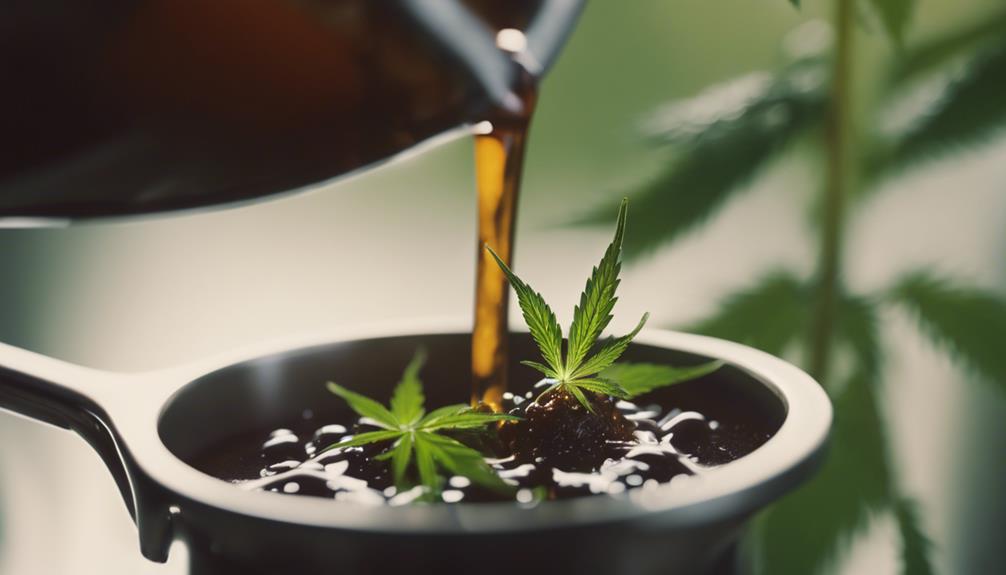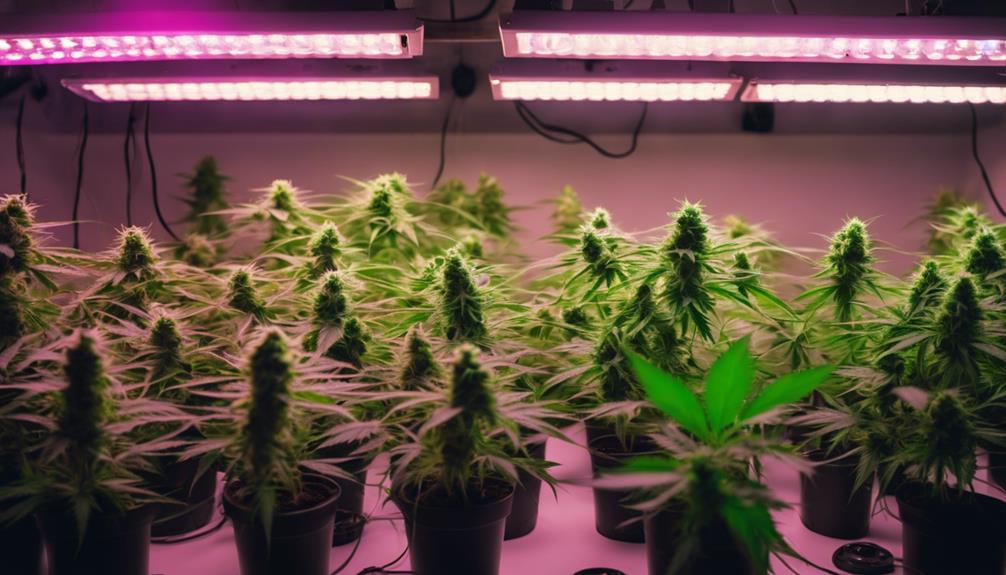I guarantee fungus gnats infesting cannabis by adjusting watering frequency, allowing topsoil to dry between waterings, and using yellow sticky traps for monitoring. Introducing beneficial nematodes and employing biological insecticides like Bacillus thuringiensis israelensis target gnat larvae effectively. Prevent reinfestation by covering soil with sand, sterilizing before planting, and using alternative growing media. Managing larvae population disrupts their life cycle and protects plants. Employing sustainable pest management practices with integrated approaches and natural predators promotes eco-friendly control. Chemical methods like insecticidal soap and neem oil offer additional options. Implementing cultural practices helps prevent future infestations. Mastering these methods guarantees successful gnat eradication.
Key Takeaways
- Use yellow sticky traps to catch adult gnats.
- Implement beneficial nematodes for larvae control.
- Apply Bacillus thuringiensis israelensis to target larvae.
- Consider neem oil as a natural insecticide.
- Use diatomaceous earth to disrupt gnat life cycles.
Identifying Fungus Gnats Infestation
When inspecting for a fungus gnat infestation, observe for the presence of small flies resembling dark-winged mosquitoes around cannabis plants. These adult gnats are a key indicator of a potential issue.
Additionally, inspect the soil for white larvae, as their presence signifies an infestation. Fungus gnats are drawn to overly moist environments, making overwatering a significant cause for concern.
The larvae feed on fungi and decaying matter in the soil, potentially harming the roots of cannabis plants and facilitating the spread of diseases like root rot. Understanding the life cycle of fungus gnats is essential in combatting infestations effectively.
Understanding Fungus Gnats Behavior
Fungus gnats exhibit a preference for environments with high moisture levels, particularly in indoor grow rooms. These pests thrive in wet conditions, laying eggs in the soil where larvae hatch and feed on fungus, decaying matter, and plant roots. Understanding their behavior is essential as larvae can damage the roots of cannabis plants, impacting nutrient absorption.
Adult gnats have a short lifespan but reproduce rapidly, leading to infestations. To monitor their presence, sticky traps can be effective in detecting adult gnats. Overwatering creates a conducive environment for fungus gnats to proliferate, emphasizing the importance of proper watering practices in cannabis cultivation to prevent infestations.
Signs of Fungus Gnats on Cannabis
In understanding the impact of fungus gnats on cannabis plants, recognizing the signs of their presence is essential. Fungus gnat infestations can be identified by small, dark flies hovering around plants and white larvae in the soil. Common signs of fungus gnat damage on cannabis include yellowing leaves, wilting, and stunted growth. These pests in the soil can lead to root damage, affecting nutrient uptake and overall plant health. Early detection of fungus gnats is vital to prevent severe infestations and minimize plant damage. By being vigilant and monitoring for these indicators, growers can take proactive measures to address the issue promptly.
| Signs of Fungus Gnats on Cannabis |
|---|
| Small, dark flies buzzing around plants |
| White larvae in the soil |
| Yellowing leaves, wilting, stunted growth |
| Root damage affecting nutrient uptake |
| Early detection vital for prevention |
Effective Monitoring Techniques
To effectively monitor fungus gnat populations in a cannabis grow area, utilizing yellow sticky traps is a recommended technique. These traps attract and capture adult fungus gnats, providing valuable insights into their activity levels.
Additionally, inspecting the topsoil for white, translucent larvae helps in evaluating the severity of a fungus gnat infestation. By burying potato disks in the soil as traps for the larvae, you can further monitor their presence and take necessary control measures.
Regularly checking the sticky traps and potato disks allows for tracking changes in fungus gnat activity and population levels. These monitoring techniques are essential for evaluating the effectiveness of control methods and fine-tuning your eradication strategy.
Implementing Cultural Practices
Implementing cultural practices such as adjusting watering routines plays a significant role in effectively managing fungus gnat infestations in cannabis plants.
To disrupt the moist conditions favored by fungus gnats, allowing the topsoil to dry out between waterings is vital. By optimizing watering practices, you can hinder fungus gnat reproduction and reduce their numbers.
Consistently maintaining dry topsoil is essential as it prevents the development and survival of fungus gnat larvae. These cultural practices, like ensuring the soil dries out adequately, are instrumental in decreasing fungus gnat infestations in cannabis plants.
Biological Control Agents
Adjusting watering routines to disrupt the moist conditions favored by fungus gnats leads to the introduction of biological control agents like Steinernema feltiae for efficient management of the pests in cannabis plants.
These beneficial nematodes are natural enemies of fungus gnat larvae and can be applied to the soil where the larvae reside. Once Steinernema feltiae enters the larvae, it releases bacteria that kill the pest, reducing their population. This eco-friendly method offers a natural approach to combat infestations without harmful chemicals.
Proper application of these biological control agents can help prevent future outbreaks and maintain a healthy growing environment for cannabis plants. Incorporating Steinernema feltiae into cultivation practices is a proactive step towards sustainable pest management.
Microbial-Based Insecticides
Utilizing microbial-based insecticides such as Bacillus thuringiensis subsp. israelensis proves highly effective in targeting and eliminating fungus gnat larvae within cannabis cultivation environments. Bacillus thuringiensis israelensis specifically acts on the larvae present in the soil, making it a safe and reliable option for biological pest control.
By applying Bacillus thuringiensis israelensis early in the production cycle, severe infestations of fungus gnats can be prevented. These microbial-based insecticides not only offer a sustainable solution but also promote eco-friendly practices in managing pests on cannabis plants.
Their safety for plants, humans, and the environment further underscores their importance in maintaining a healthy cultivation environment while effectively combating fungus gnat populations.
Preventing Fungus Gnats Reinfestation
To prevent reinfestation of fungus gnats, covering the soil with sand or gravel acts as a barrier against adult gnats laying eggs. Implementing proper watering practices is essential, as overwatering creates a hospitable environment for fungus gnat eggs or larvae.
Sterilizing the soil before planting can eliminate any existing eggs or larvae, preventing future infestations. Using alternative growing media like coco coir or perlite can deter fungus gnats from inhabiting the soil. Additionally, allowing the soil to dry out between waterings can help deter reinfestation.
Integrated pest management strategies should be employed to effectively control and prevent fungus gnat reinfestations, ensuring a healthy environment for cannabis plants.
Managing Fungus Gnats Larvae Population
To effectively manage the population of fungus gnat larvae, proactive measures must be taken to disrupt their life cycle and minimize potential damage to cannabis plants. Fungus gnat larvae thrive in moist environments, often due to overwatering, where they feed on fungi and decaying matter, causing root damage and plant stress.
Identifiable by their white, transparent bodies and black head capsules, these larvae go through four stages before pupating and emerging as adult gnats. Populations can fluctuate based on factors like plant size, age, and environmental conditions.
Early detection of larvae infestations is critical for effective management. By understanding the lifecycle and habits of these larvae, interventions can be tailored to reduce their numbers and protect cannabis plants from harm.
Sustainable Pest Management Practices
When implementing sustainable pest management practices for controlling fungus gnats, integrated approaches are key to effectively address the issue.
- Utilize beneficial nematodes to target fungus gnat larvae efficiently.
- Employ yellow sticky traps as a monitoring tool for fungus gnat populations.
- Consider natural remedies such as neem oil and diatomaceous earth for eco-friendly control.
- Maintain proper watering practices to prevent fungus gnat infestations in cannabis plants.
Will Getting Rid of Cannabis Smell Also Help Eliminate Fungus Gnats?
Yes, getting rid of cannabis odor can also help eliminate fungus gnats. Fungus gnats are attracted to the strong smell of cannabis, so by removing the odor, you can reduce the presence of these pests. Additionally, keeping the area clean and dry can further deter fungus gnat infestations.
Frequently Asked Questions
What Kills Fungus Gnats in Cannabis?
Sticky traps, neem oil, and proper watering can naturally control fungus gnats in cannabis. Incorporate diatomaceous earth, beneficial nematodes, and hydrogen peroxide for effective soil drenching. Utilize cinnamon powder, sand top dressing, and reduce humidity.
How Do I Get Rid of Fungus Gnats Asap?
To get rid of fungus gnats asap, I implement natural remedies like neem oil and diatomaceous earth for soil treatment. Yellow sticky traps are effective trap methods. I also use essential oils and biological controls to prevent infestations in indoor gardening.
How Do You Kill Fungus Gnats in a Grow Tent?
To kill fungus gnats in a grow tent, I employ natural remedies such as soil drenches with hydrogen peroxide, sticky traps, neem oil applications, diatomaceous earth sprinkling, beneficial nematodes introduction, cinnamon powder, apple cider vinegar, and sand topdressing for efficient control.
How Do You Get Rid of Fungus Gnats Infestation?
To rid a fungus gnat infestation, I recommend using natural remedies like neem oil or hydrogen peroxide for soil treatment. Implementing pest control tactics, prevention methods, and DIY traps can help combat these pests in indoor plants effectively.
Conclusion
In summary, effectively managing fungus gnats infestations on cannabis requires a combination of monitoring, cultural practices, and microbial-based insecticides.
By identifying the signs of infestation early and implementing sustainable pest management practices, growers can prevent reinfestation and reduce the population of fungus gnat larvae.
It's crucial to stay vigilant and proactive in controlling these pests to guarantee the health and vitality of cannabis plants.




